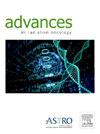水凝胶垫片直肠壁浸润深度与直肠毒性无关:一项随机前瞻性试验的结果
IF 2.2
Q3 ONCOLOGY
引用次数: 0
摘要
目的直肠垫片作为前列腺癌放射治疗(RT)的一种节省剂量的材料,受到了越来越多人的青睐。然而,该手术可能与间隔凝胶的意外直肠壁浸润(RWI)有关。因此,我们利用一项前瞻性随机临床试验(RCT)中接受 RT 治疗的前列腺癌患者的数据集,将 RWI 严重程度作为深度的函数进行了分类,并探讨了其与直肠毒性的关联性。方法与材料在一项已发表的多中心 RCT 中,我们对 149 名随机接受水凝胶垫片治疗的受试者的植入后 T2 加权磁共振图像进行了评估,以确定是否存在 RWI 及其深度。所有植入物的得分分别为 0 分(无直肠壁信号变化)、1 分(直肠壁水肿/信号变化)、2 分(部分 RWI)或 3 分(全厚 RWI);RWI 被定义为 2 分或 3 分。结果虽然 62.4% 的植入物没有直肠壁信号异常,但 24% 的植入物[评分为 2(20.1%)和 3(4.0%)]显示出 RWI 的影像学证据。全厚 RWI 与直肠浸润的长度较长(22.8 ± 7.0 mm,P = .008)和圆周百分比较大(35.8% ± 9.2%,P = .045)有关。虽然有 7 名受试者(5%)出现了与手术相关的一过性直肠毒性反应(最常见的是会阴/直肠疼痛),但只有一人出现了 RWI(评分为 2,美国国家癌症研究所不良事件通用术语标准 1 级)。因此,在手术直肠毒性与 RWI 的存在/程度之间未观察到相关性(P = 0.64)。同样,在 RWI 类别之间也没有发现急性(P = .64)或晚期(P = .85)直肠毒性发生率或等级的差异;在 RWI 评分为 3 的 6 名男性中,没有一人在 15 个月后出现晚期直肠毒性。本文章由计算机程序翻译,如有差异,请以英文原文为准。
Depth of Hydrogel Spacer Rectal Wall Infiltration Was Not Associated With Rectal Toxicity: Results From a Randomized Prospective Trial
Purpose
Rectal spacers have gained popularity as a dose-sparing material for prostate cancer radiation therapy (RT). However, the procedure can be associated with unintended rectal wall infiltration (RWI) of the spacer gel. We therefore classified RWI severity as a function of depth and explored its association with rectal toxicity using a data set from prostate cancer patients treated with RT on a prospective randomized clinical trial (RCT).
Methods and Materials
Postimplant T2-weighted magnetic resonance images of 149 subjects randomized to the hydrogel spacer arm of a published multicenter RCT were assessed for the presence and depth of RWI. All implants were assigned a score of 0 (no rectal wall signal changes), 1 (rectal wall edema/signal change), 2 (partial RWI), or 3 (full-thickness RWI); RWI was defined as a score of 2 or 3. Correlations were made between RWI score and physician-reported procedure, acute, and late rectal toxicity.
Results
Although 62.4% of implants had no rectal wall signal abnormalities, 24% [scores of 2 (20.1%) and 3 (4.0%)] of procedures exhibited radiographic evidence of RWI. Full-thickness RWI was associated with both a longer length (22.8 ± 7.0 mm, P = .008) and a larger circumferential percentage (35.8% ± 9.2%, P = .045) of rectal infiltration. Although 7 subjects (5%) experienced transient procedure-related rectal toxicities (most commonly perineal/rectal pain), only one had RWI (score of 2, National Cancer Institute's Common Terminology Criteria for Adverse Events grade 1). Consequently, no correlation was observed between procedural rectal toxicity and the presence/extent of RWI (P = .64). Similarly, no difference in acute (P = .64) or late (P = .85) rectal toxicity incidence or grade was detected between RWI categories; none of the 6 men with a RWI score of 3 developed late rectal toxicity by 15 months.
Conclusions
Based on data from an RCT, RWI did not contribute to increased rectal toxicity prior and up to 15 months after conventional prostate cancer RT.
求助全文
通过发布文献求助,成功后即可免费获取论文全文。
去求助
来源期刊

Advances in Radiation Oncology
Medicine-Radiology, Nuclear Medicine and Imaging
CiteScore
4.60
自引率
4.30%
发文量
208
审稿时长
98 days
期刊介绍:
The purpose of Advances is to provide information for clinicians who use radiation therapy by publishing: Clinical trial reports and reanalyses. Basic science original reports. Manuscripts examining health services research, comparative and cost effectiveness research, and systematic reviews. Case reports documenting unusual problems and solutions. High quality multi and single institutional series, as well as other novel retrospective hypothesis generating series. Timely critical reviews on important topics in radiation oncology, such as side effects. Articles reporting the natural history of disease and patterns of failure, particularly as they relate to treatment volume delineation. Articles on safety and quality in radiation therapy. Essays on clinical experience. Articles on practice transformation in radiation oncology, in particular: Aspects of health policy that may impact the future practice of radiation oncology. How information technology, such as data analytics and systems innovations, will change radiation oncology practice. Articles on imaging as they relate to radiation therapy treatment.
 求助内容:
求助内容: 应助结果提醒方式:
应助结果提醒方式:


